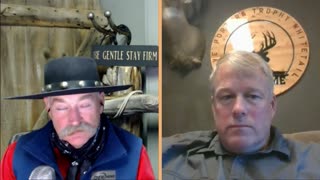Premium Only Content

James Webb Telescope Is FINALLY Proving Existence Of White Holes!
Many have heard about the space monsters called black holes! They are terrifying large
objects that we can't see but swallow everything that they encounter, including stars and
light! However, there are other even more mysterious objects lurking in the Universe,
which are the direct opposite of black holes; white holes! Scientists have tried to unlock
the secrets of white holes without success! However, scientists have a new weapon in
space; the James Webb Space Telescope! What are white holes, and where do they
come from? In this video, we will show you how the new James Webb Telescope will
prove scientists right about white hole theory!
The James Webb Space Telescope is a 10 billion dollar gamble that launched to space
late last year. However, the James Webb Space Telescope has reached its final
destination, almost a month after launch! Since lifting off from French Guiana on
December 25, the telescope has unfurled its tennis court-size sunshield and unfolded a
massive gold mirror that will help it study the Universe in new ways and peer inside the
atmosphere of exoplanets. The telescope's observation point is nearly a million miles
away from Earth and beyond the moon itself. The space observatory experienced its
final burn on and has entered the orbit called L2.
NASA reports that if Ariane 5, the launch rocket, had been going even a little bit faster,
the telescope may have overshot the orbit and exposed its mirror and instruments to the
sun if it had to slam on the brakes. But the Ariane 5 targeted the JWST so accurately
that the first and most critical burn was smaller than NASA had to plan and design for,
leaving more fuel for an extended mission. So, instead of the initial ten-year estimated
life span, the JWST now has enough fuel to keep working for 20 years!
The JWST will actually orbit the sun and remain in line with the Earth. Thanks to
thrusting every three weeks or so, it will stay in orbit from small rocket engines aboard.
The L2 point is ideal for the JWST because the gravitational forces of the sun and Earth
will basically ensure the spacecraft doesn't have to use much thrust to stay in orbit. And
it will allow the telescope to have an unimpeded view of the Universe, unlike Hubble,
which moves in and out of Earth's shadow every 90 minutes. Because the JWST works
with infrared, it needs to be kept as cool as possible. This is why the spacecraft has a
five-layer sunshield that keeps the giant mirror and instruments from the sun's blistering
rays and maintains a very frigid negative 370 degrees Fahrenheit or negative 223
degrees Celsius!
With the JWST now in orbit, the spacecraft will spend the next five months calibrating its
instruments. The first images captured by the observatory will come around this
summer this year. NASA promises that they will be stunning and worth all the billions of
dollars and person-hours!
The JWST's primary mission focuses on four main areas: first light in the Universe,
assembly of galaxies in the early Universe, the birth of stars and protoplanetary systems
and planets, including the origins of life! It will stare billions of years into the past, taking
us as closest as possible to the Big Bang! One of the deep space mysteries this space
telescope will solve is the truth about white holes! What truth will the JWST uncover
about these unknown but mighty objects? First, what are white holes?
To understand white holes, it is important to know about black holes. These
gravitational monsters called black holes are like the vacuum cleaners of the Universe,
greedily sucking up anything within reach! The strength of their pull is immense, so
strong that light itself cannot escape once it has crossed the black hole's event horizon,
known as the point of no return!
You can't even see a black hole since no light or radiation can escape from its pull, but
astronomers are able to locate them due to the gravitational effects they have on stellar
bodies around them. For example, every galaxy has a supermassive black hole at its
center, which may have formed at the same time as the galaxy itself. These black holes
may contain a mass of more than 1 million suns yet be compressed into a ball the size
of a single sun, making them infinitely dense! That ball is called a singularity.
Medium-sized black holes, called stellar black holes, are created at the end of a star's
life after undergoing the volatile expansion, contraction, and explosion of a supernova.
Not all stars will experience this dramatic death, but the biggest ones invariably do. The
most minor black holes often referred to as primordial black holes, are thought to have
been formed at the very start of the Universe, during the first few instants following the
-
 10:47
10:47
Future Space
2 years agoIt's Reality! Astronomers Might've Found First Ever White Hole
61 -
 1:12:00
1:12:00
The Car Guy Online
14 hours ago $1.63 earnedAutomakers EXPOSED, Whistleblowers SILENCED! NextGen Engineer Speaks Out!
12.5K10 -
 1:17
1:17
The Lou Holtz Show
15 hours agoThe Lou Holtz Show S2 EP16 | Hugh Freeze on Faith, Football & Restoring American Values #podcast
20.6K2 -
 2:01:21
2:01:21
BEK TV
1 day agoTrent Loos in the Morning - 8/22/2025
21.9K -
 LIVE
LIVE
The Bubba Army
23 hours agoHogan's Death: Bubba Called it FIRST AGAIN! - Bubba the Love Sponge® Show | 8/22/25
1,776 watching -
 38:40
38:40
ZeeeMedia
18 hours agoMax Pace’s Crypto Revolution Story: Four Strategies to Win | Daily Pulse Ep 93
33.3K14 -
 2:16:46
2:16:46
"What Is Money?" Show
2 days agoBitcoin vs War, Violence, & Corruption w/ Gary Mahmoud
28.7K -
 28:33
28:33
DeVory Darkins
1 day ago $9.95 earnedNewsom suffers stunning EMBARRASSMENT as MAJOR retailer makes devastating announcement
33K62 -
 32:46
32:46
Coin Stories with Natalie Brunell
2 days agoInside Look at Strategy’s $70+ Billion Bitcoin Treasury
23.3K1 -
 8:21
8:21
MattMorseTV
19 hours ago $9.26 earnedTrump just SCORED a $500,000,000 LEGAL WIN.
121K47